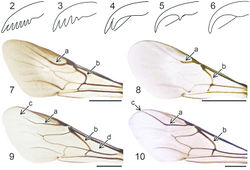Chrysis longula
| Notice: | This page is derived from the original publication listed below, whose author(s) should always be credited. Further contributors may edit and improve the content of this page and, consequently, need to be credited as well (see page history). Any assessment of factual correctness requires a careful review of the original article as well as of subsequent contributions.
If you are uncertain whether your planned contribution is correct or not, we suggest that you use the associated discussion page instead of editing the page directly. This page should be cited as follows (rationale):
Citation formats to copy and paste
BibTeX: @article{Paukkunen2015ZooKeys, RIS/ Endnote: TY - JOUR Wikipedia/ Citizendium: <ref name="Paukkunen2015ZooKeys">{{Citation See also the citation download page at the journal. |
Ordo: Hymenoptera
Familia: Chrysididae
Genus: Chrysis
Name
Chrysis longula Abeille de Perrin, 1879 – Wikispecies link – Pensoft Profile
- Chrysis ignita var. longula Abeille de Perrin, 1879: 74.
- Chrysis longula var. sublongula Linsenmaier, 1951: 76.
- Chrysis longula ssp. aeneopaca Linsenmaier, 1959: 160.
- Chrysis longula: Linsenmaier 1959[1]: 159.
Diagnosis
Length 10–13 mm. The body is elongate with parallel sides (Fig. 102) and usually large compared to other species of the Chrysis ignita group. The head and mesosoma are dorsally blue or black, and the female has extensive golden green reflections on the pronotum, mesopleuron and mesoscutellum. The punctures of the mesoscutum are usually lighter coloured than the interstices (as in Chrysis impressa). The tergites and sternites are golden red (Figs 102, 121) and the black spots of S2 are long and narrow (Fig. 121). The punctation of T2 is anteriorly very coarse, and the surface of T3 is shiny in the female (Fig. 102). The mandible is long and relatively thick (in the male as in Fig. 146). Small specimens can be confused with Chrysis angustula and Chrysis corusca, but the punctation of T2 is coarser anteriorly and the black spots of S2 are narrower. The sternites are mostly red, not greenish as in Chrysis corusca. The males are often difficult to distinguish from Chrysis impressa and Chrysis subcoriacea. Compared to Chrysis impressa, the sternites are usually brighter red and the black spots of S2 are more elongate. The punctation of T2 is coarser anteriorly and the metasoma is more elongate in shape. Compared to Chrysis subcoriacea, the pronotum is more abruptly bicoloured (Fig. 161), the punctation of T2 is usually coarser anteriorly, the lateral margin of T3 is more concave and the central interval of the apical teeth is more arcuate (Fig. 88).
Distribution
Denmark, Estonia, Finland, Latvia, Lithuania, Norway, Sweden. Relatively rare. – Trans-Palearctic: from western Europe to central Asia, Siberia and China (Linsenmaier 1959[1], 1997[2], Rosa et al. 2014[3]).
Biology
Habitat: forest margins, clearings and gardens with sun-exposed dead wood. Adults can be found on walls of old log buildings (barns, sheds etc.), log piles, poles and dead tree trunks (e.g. Betula, Populus, Salix). Flight period: early June to late August. Host: Ancistrocerus antilope (Panzer), Symmorphus crassicornis (Panzer) and Symmorphus murarius (Linnaeus) (Linsenmaier 1959[1], Heinrich 1964[4], Morgan 1984[5], Brechtel 1985[6], Petit 1987[7], Martynova and Fateryga 2015[8]), possibly also Ancistrocerus parietinus (Linnaeus) and species of Euodynerus Dalla Torre (Vespidae) (Blüthgen 1961[9], Morgan 1984[5], Martynova and Fateryga 2015[8]).
Remarks
Eastern Palearctic populations of Chrysis longula belong to ssp. aeneopaca Linsenmaier, 1959 which differs from the nominotypical subspecies by having fine punctation and brownish colour anteriorly on tergites. Specimens of ssp. aeneopaca can sometimes be confused with Chrysis subcoriacea. One specimen similar to ssp. aeneopaca has been found in Finland (Kuopio), but the occurrence of the taxon in Fennoscandia is questionable (Paukkunen et al. 2014[10]).
Taxon Treatment
- Paukkunen, J; Berg, A; Soon, V; Ødegaard, F; Rosa, P; 2015: An illustrated key to the cuckoo wasps (Hymenoptera, Chrysididae) of the Nordic and Baltic countries, with description of a new species ZooKeys, (548): 1-116. doi
Images
|
Other References
- ↑ 1.0 1.1 1.2 Linsenmaier W (1959) Revision der Familie Chrysididae (Hymenoptera) mit besonderer Brücksichtigung der europäischen Spezies. Mitteilungen der Schweizerischen Entomologischen Gesellschaft 32: 1–232.
- ↑ Linsenmaier W (1997) Die Goldwespen der Schweiz. Veröffentlichungen aus dem Natur-Museum Luzern 9: 1–139.
- ↑ Rosa P, Wei N, Xu Z (2014) An annotated checklist of the chrysidid wasps (Hymenoptera, Chrysididae) from China. ZooKeys 455: 1–128. doi: 10.3897/zookeys.455.6557
- ↑ Heinrich J (1964) Beitrag zur Hymenopteren-fauna des westlichen Unterfranken. 1. Teil, Chrysididae. Nachrihten des Naturwissenschaftlichen Museums der Stad Aschaffenburg 71: 1–28.
- ↑ 5.0 5.1 Morgan D (1984) Cuckoo-wasps, Hymenoptera, Chrysididae. Handbooks for the Identification of British Insects, Vol. 6, Part 5. Royal Entomological Society of London, London, 37 pp.
- ↑ Brechtel F (1985) Naturschutzbezogene Erfassung der Stechimmenfauna des Bienwaldes und seiner Randbereiche (Südpfalz) unter besonderer Berücksichtigung der Ökologie Kunstnest-bewohnender Arten. Diss. Univ., Karlsruhe, 437 pp.
- ↑ Petit J (1987) Notes faunistiques et éthologiques sur les Chrysides de la Belgique et des régions limitrophes (Hymenoptera Chrysididae). 4. Lambillionea 87: 29–35.
- ↑ 8.0 8.1 Martynova K, Fateryga A (2015) Chrysidid wasps (Hymenoptera, Chrysididae) – parasites of eumenine wasps (Hymenoptera, Vespidae: Eumeninae) in Crimea. Entomological Review 95: 472–485. doi: 10.1134/S0013873815040090
- ↑ Blüthgen P (1961) Die Faltenwespen Mitteleuropas (Hymenoptera, Diploptera). Abhandlungen der Deutschen Akademie der Wissenschaften zu Berlin 2: 7–240.
- ↑ Paukkunen J, Rosa P, Soon V, Johansson N, Ødegaard F (2014) Faunistic review of the cuckoo wasps of Fennoscandia, Denmark and the Baltic countries (Hymenoptera: Chrysididae). Zootaxa 3864: 1–67. doi: 10.11646/zootaxa.3864.1.1





